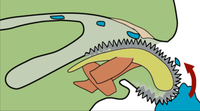Nutrition
Patera panselenus is a terrestrial snail meaning it breathes air (Subclass: Pulmonata) (Hickman et. al, 2011). Being a terrestrial snail it often consumes matter such as leaves and other tree remains making them herbivores (Hickman et al., 2011). Some gastropods can also eat decomposing organisms, detritivores, and others scrape off and eat fungi, making them mycophagists (Martin, 2000). Terrestrial snails can also be carnivores, meaning they consume other organisms, but this form of feeding is rare to our particular snail and other terrestrial snails (Hickman et al., 2011).
 Terrestrial
snails, use a structure called a radula to pick up and consume their
food (Zip Code Zoo, 2012). A radula is an organ that projects
from their mouth, almost acting as a type of tongue, to help them collect
their food (Zip Code Zoo, 2012).
Along the radula are many small teeth called chitinous teeth
(Hickman et al., 2011). Chitinous
teeth maintain grip on the substance it is
collecting/eating so it can be passed through the rest of the
digestive tract of the terrestrial species (Hickman et al., 2011).
To the left is an illustration that may help you better
understand a terrestrial snail's radula (Zip
Code Zoo, 2012).
Terrestrial
snails, use a structure called a radula to pick up and consume their
food (Zip Code Zoo, 2012). A radula is an organ that projects
from their mouth, almost acting as a type of tongue, to help them collect
their food (Zip Code Zoo, 2012).
Along the radula are many small teeth called chitinous teeth
(Hickman et al., 2011). Chitinous
teeth maintain grip on the substance it is
collecting/eating so it can be passed through the rest of the
digestive tract of the terrestrial species (Hickman et al., 2011).
To the left is an illustration that may help you better
understand a terrestrial snail's radula (Zip
Code Zoo, 2012).
After the terrestrial snail takes up food using their radula, it is then taken to its crop (Hickman et al., 2011). The crop of a snail is part of the digestive tract where the food is stored before it is then sent for further digestion (Hickman et al., 2011). After being stored in the crop it will then be sent to the lumen where it will undergo extracellular digestion (Hickman et al. 2011). Extracellular digestion is a type of digestion which the food particles are digested outside of a cell rather than inside, intracellular (Biology Online, 2012).
Home Continue onto Reproduction